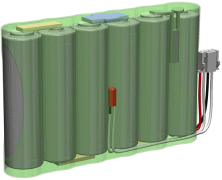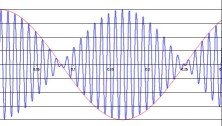Electrical Engineering Definitions
"A"
"B",
"C",
"D",
"E",
"F",
"G",
"H",
"I",
"J",
"K",
"L",
"M",
"N",
"O",
"P",
"Q",
"R",
"S",
"T",
"U",
"V",
"W",
"X",
"Y",
"Z"
"B" to "Bas",
"Bat" to "Bim",
"Bin" to "Bn",
"Bo" to "Bq", "Br" to "Buq", "Bur" to "Bz"
Battery. A device for converting chemical energy into electrical energy. A group of two or more connected voltaic cells. Electronic Battery Manufacturers, or Industrial Battery Manufacturers.
Battery Capacity. The amount of energy available from a battery. Battery capacity is expressed in
ampere-hours.
Battery Pack. Two or more individual batteries connected together to form a larger capacity battery delivering more current or more voltage than the individual batteries.
Baud. A unit of signaling speed. A measurement of speed based on the number of code elements or units per second. Refer to Definition of Baud.
Bayonet Coupling. A quick coupling device for plug and receptacle connectors, accomplished by rotation of a cam operating device designed to bring the connector halves together. Read more on Bayonet Coupling Connector.
Bayonet Fitting. Same as Bayonet Coupling.
Beam: A column of light. The main lobe of an antenna radiation
pattern. Also refer to the section covering Antenna Terms.
Beam-Lead Chip. Semiconductor chip with electrodes (leads) extended beyond the wafer.
Beam-Power Tube. An electron tube in which the grids are aligned with the control grid. Special
beam-forming plates are used to concentrate the electron stream into a beam. Because of this action, the beam-power tube has high power-handling capabilities.
Beam Splitter: A device for dividing an optical beam
into two or more separate beams. Note: An example
of a beam-splitter is a partially reflecting mirror.
Bearing. An angular measurement of the direction of an object from a reference direction, such as true north.
Beat Frequencies. Difference and sum frequencies, which result from the combination of two
separate frequencies.
Beat Frequency. The frequency produced when two signals are mixed or combined. The beat frequency equals the difference or offset between the two frequencies. The difference between the oscillator frequency and the unknown audio frequency.
Beat Frequency Oscillator. An additional oscillator used in a receiver when it is receiving a
cw signal. It provides an audible tone. Also refer to a related topic on Oscillator Manufacturers & vendors.
BEL. A unit of measure of ratios of power levels. The unit that expresses the logarithmic ratio between the input and output of any given component, circuit, or system. bel; [B] = log 10(P1/P2) where P1 and P2 are power levels. The dB, equal to 0.1 B, is a more commonly used unit.
Benchmark. A software routine used to test and compare different microprocessors using the same code and comparing the time to reach a final result.
Bench Test. Any test performed in the lab that simulates the actual I/O the system will encounter. Related topic; Design for Test.
Bend Loss. The attenuation of a signal that results from bending a fiber optic cable.
Bend Radius. The minimum radius to which a cable, without tensile load, can be bent for
its lifetime without causing broken wires or fibers, a localized weakening of the fibers, or a
permanent increase in attenuation.
Beryllium Copper. [BeCu] A relatively expensive contact material with properties superior to brass and phosphor bronze. It is recommended for contact applications requiring repeated extraction and reinsertion because of its resistance to fatigue at high operating temperatures.
BETA. The ratio of a change in collector current to a corresponding change in base current when the collector voltage is constant in a common-emitter circuit.
Bias. Difference of potential applied to a transistor or vacuum tube to establish a reference operating level. Electrical, mechanical, magnetic, or other force (field) applied to a device to establish a reference level to operate the device. Bias resistors which fix the steady state current are shown for a transistor circuit to the right.
Bias Current. Current that flows through the base-emitter junction of a transistor and is adjusted to set the operating point of the transistor. Transistor Schematics
Bias Resistor. A resistor used add a bias voltage a circuit. Also refer to Bias Resistor from the resistor dictionary section.
Bias Tee. A method of adding a DC bias voltage to a coaxial line through one port of the Tee connection which is than received by another port, while being block by a capacitor from reaching the third port. Normally found in some forms of T connectors.
Bi-CMOS. An integrated circuit that combines both bipolar junction transistors and complementary MOS transistors [CMOS].
BiFET. [BI-FET] A circuit that uses a combination of Bipolar Transistor devices and Field Effect Transistor devices. The term is normally used in regard to semiconductors, and the FET is usually a JFET. In relation to an operational amplifier a FET is used as the input gate [to show high impedance to the input signal] while the transistors form much of the rest of the circuitry.
Bifilar Transformer. A transformer with the winding of the primary and secondary windings are wound side by side.
Bifilar Winding. Two or more windings with the wire of each winding alongside the other, matching turn for turn, carrying the same current but in opposite directions; may be either inductive or noninductive [Relays].
Bifurcated Contact. A forked contact to provide two mating surfaces, in parallel, to provide a better mating surface. A set of contacts in which the movable or stationary contact configuration is divided to
provide two mating contact surfaces in parallel.
Big-Endian. A format for storage or transmission of binary data in which the most significant byte
appears first. In a multi-byte value, the byte containing the most significant bit is stored in the lowest memory address and transmitted first, and the byte containing the least significant bit is stored in the highest memory address and transmitted last.
Bilateral Switch. A semiconductor analog switch that functions the same regardless of how the switch is used, or inserted into the circuit. As the switch operates the same regardless or the orientation of the two switch contacts in the circuit. Read more on Analog Switches. A CMOS 4016, or a TTL 74LVC1G384 [to name just two].
Bi-Level Signal. A signal that is comprised of only two levels.
Bimetal Switch. A type of switch designed to turn on or off based on temperature. More detail on Thermostatic Switches.
Bi-Phase Level. A method of representing digital data where a level change occurs at the center of every bit period. A one is represented of a high level with a mid-bit transition to a low level. A zero is represented by a low level with a mid-bit transition to a high level.












